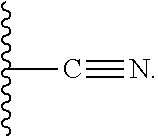5,7-Dihydro-Pyrrolo-Pyridine Derivatives
a technology of pyrrolopyridine and dihydropyrrolopyridine, which is applied in the field of new products, can solve the problems of partial responsiveness and debilitating disruption of the daily life of peopl
- Summary
- Abstract
- Description
- Claims
- Application Information
AI Technical Summary
Benefits of technology
Problems solved by technology
Method used
Image
Examples
example 1
1-(2,4-Dimethyl-5,7-dihydro-6H-pyrrolo[3,4-b]pyridin-6-yl)-2-[1-(pyridin-3-yl)azetidin-3-yl]ethanone (1)
[0428]
Step 1. Synthesis of tert-butyl 3-(2-ethoxy-2-oxoethylidene)azetidine-1-carboxylate (C39)
[0429]tert-Butyl 3-oxoazetidine-1-carboxylate (100 g, 584 mmol) was dissolved in dichloromethane (750 mL), cooled in an ice bath, and vigorously stirred while (carboethoxymethylene)triphenylphosphorane (220 g, 631 mmol) was added portion-wise over 15 minutes. The reaction mixture was then heated to 40° C. for 4 hours, whereupon most of the dichloromethane was removed in vacuo. The resulting thick slurry was diluted with a mixture of hexanes and tert-butyl methyl ether (2:1, 1 L), and stirred at room temperature for 1.5 hours. Triphenylphosphine oxide was removed via filtration; the filter cake was washed with a 2:1 mixture of hexanes and tert-butyl methyl ether, and the combined filtrates were concentrated in vacuo. Silica gel chromatography (Eluent: 2:1 hexanes / tert-butyl methyl ether) ...
example 2
2-{1-[2-(Difluoromethyl)pyridin-4-yl]azetidin-3-yl}-1-(2,4-dimethyl-5,7-dihydro-6H-pyrrolo[3,4-b]pyridin-6-yl)ethanone (2)
[0436]
Step 1. Synthesis of 4-chloro-2-(difluoromethyl)pyridine (C44)
[0437]A solution of (diethylamino)sulfur trifluoride (854 mg, 5.30 mmol) in dichloromethane (5 mL) was added in a drop-wise manner to a −30° C. (dry ice-acetonitrile bath) solution of 4-chloropyridine-2-carbaldehyde (500 mg, 3.5 mmol) in dichloromethane (15 mL). The reaction mixture was stirred at −30° C. for 4 hours, and then allowed to warm to room temperature and stir for 16 hours. The reaction was quenched via addition of ice and was then basified to pH 8-10 by addition of saturated aqueous sodium bicarbonate solution. The resulting mixture was extracted with dichloromethane (3×50 mL), and the combined organic layers were washed with saturated aqueous sodium chloride solution (2×50 mL), dried over sodium sulfate, filtered, and concentrated in vacuo at low temperature, affording the product as...
example 3
1-(2,4-Dimethyl-5,7-dihydro-6H-pyrrolo[3,4-b]pyridin-6-yl)-2-[1-(pyrimidin-4-yl)azetidin-3-yl]ethanone (3)
[0440]
Step 1. Synthesis of [1-(tert-butoxycarbonyl)azetidin-3-yl]acetic acid (C46)
[0441]Lithium hydroxide (862 mg, 36.0 mmol) was added to a solution of C40 (7.30 g, 30.0 mmol) in a mixture of tetrahydrofuran (40 mL) and water (10 mL), and the reaction mixture was stirred at 20° C. for 2 hours. The reaction mixture was adjusted to a pH of 4 via addition of 1 M aqueous hydrochloric acid, and the resulting mixture was extracted with ethyl acetate (3×100 mL). The combined organic layers were washed sequentially with water (100 mL) and with saturated aqueous sodium chloride solution (100 mL), dried over sodium sulfate, filtered, and concentrated in vacuo to provide the product as a white solid. Yield: 6.0 g, 28 mmol, 93%. 1H NMR (400 MHz, CD3OD) δ 4.06 (dd, J=8.5, 8.3 Hz, 2H), 3.61 (dd, J=8, 6 Hz, 2H), 2.94-2.82 (m, 1H), 2.62 (d, J=7.8 Hz, 2H), 1.43 (s, 9H).
Step 2. Synthesis of tert...
PUM
| Property | Measurement | Unit |
|---|---|---|
| Temperature | aaaaa | aaaaa |
| Volume | aaaaa | aaaaa |
| Volume | aaaaa | aaaaa |
Abstract
Description
Claims
Application Information
 Login to View More
Login to View More - R&D
- Intellectual Property
- Life Sciences
- Materials
- Tech Scout
- Unparalleled Data Quality
- Higher Quality Content
- 60% Fewer Hallucinations
Browse by: Latest US Patents, China's latest patents, Technical Efficacy Thesaurus, Application Domain, Technology Topic, Popular Technical Reports.
© 2025 PatSnap. All rights reserved.Legal|Privacy policy|Modern Slavery Act Transparency Statement|Sitemap|About US| Contact US: help@patsnap.com



